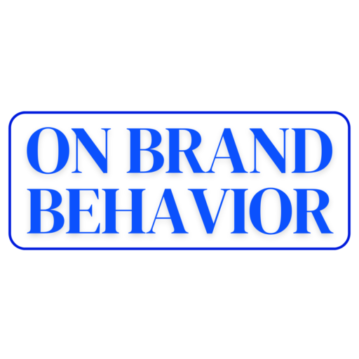What makes a brand impossible to ignore? Why do certain companies capture attention effortlessly, while others struggle to make an impact—despite having great products?
The answer lies in behavioral science—the study of how people think, make decisions, and take action. Branding isn’t just about aesthetics; it’s about triggering the right psychological responses to create trust, authority, and influence.
Let’s break down how you can use behavioral science to build a brand that attracts attention, keeps customers engaged, and drives long-term loyalty.
What is Behavioral Science, and Why Does It Matter in Branding?
Behavioral science focuses on understanding why people act the way they do. Every time a person interacts with a brand, their brain is processing cues, associations, and subconscious triggers that shape their perception.
If your brand intentionally designs these experiences, you can:
✅ Make people feel instantly connected to your brand
✅ Drive trust and credibility without “hard selling”
✅ Increase engagement, conversions, and long-term loyalty
If you don’t apply behavioral science, your brand is just hoping people “get it” on their own.
🚀 Example: Why do people line up for the latest iPhone, even when the previous version works fine?
• Apple designs anticipation through limited leaks, teasers, and controlled scarcity.
• They reinforce habit formation—every iPhone works the same, so upgrading feels familiar.
• They create identity alignment—owning an iPhone isn’t just about tech; it’s a status symbol.
Apple doesn’t just sell phones—they sell psychological triggers.
The 5 Behavioral Science Principles That Make Brands Unforgettable
1. The Halo Effect: People Judge a Brand Based on Their First Impression
If the first impression is positive, everything else about the brand is viewed favorably. If it’s negative, the opposite happens. This is why some brands feel premium, trustworthy, or high-status—even before people use their products.
🚀 Example:
• Luxury brands like Rolex or Louis Vuitton create exclusivity in their presentation—sleek stores, personalized service, high prices. This makes people assume quality.
• A brand with high-end visuals, a polished website, and strong messaging automatically feels more valuable, even before customers experience the product.
🔹 How to Apply This:
• Make sure your website, visuals, and messaging create a strong first impression.
• Use design, copy, and consistency to position yourself as an expert.
• Don’t cut corners—every brand touchpoint matters.
2. Commitment & Consistency: Once People Buy In, They Stick
People want to stay consistent with past decisions—once they commit to a brand, they are less likely to switch.
🚀 Example:
• Subscription models (Netflix, Spotify, Adobe) make people commit to monthly payments, increasing loyalty over time.
• Starbucks’ rewards system keeps customers coming back because they feel invested in earning free drinks.
• Apple users rarely switch to Android because they’ve already built habits, bought accessories, and committed to the ecosystem.
🔹 How to Apply This:
• Encourage small commitments early (free trials, opt-ins, community participation).
• Create habit loops—rewards, exclusivity, or consistency in user experience.
• Make it easier to stay than to leave.
3. Loss Aversion: People Hate Losing More Than They Love Winning
People are twice as motivated to avoid loss as they are to gain something new. This is why scarcity, urgency, and exclusivity drive sales faster than discounts.
🚀 Example:
• Airlines use “Only 3 seats left at this price!” to trigger fear of missing out.
• High-end brands limit production to maintain exclusivity (Rolex, Hermès).
• Software companies offer free trials but remind you what you’ll lose if you cancel.
🔹 How to Apply This:
• Use limited-time offers, exclusive access, and countdown timers to increase urgency.
• Frame offers in terms of loss (ex: “Don’t miss out on this opportunity” vs. “Get this deal”).
• Reinforce what people will miss if they don’t engage.
4. Social Proof: People Follow What Others Are Doing
Humans are wired to look at others for decision-making guidance. Brands that leverage testimonials, case studies, and endorsements automatically gain credibility.
🚀 Example:
• Amazon products with thousands of 5-star reviews get more sales than those with none.
• Restaurants with long lines appear more desirable than empty ones.
• High-ticket coaches display “As Seen In” media logos (Forbes, Inc., Business Insider) to position themselves as authorities.
🔹 How to Apply This:
• Showcase testimonials, user-generated content, and reviews prominently.
• Highlight numbers (“Trusted by 10,000+ customers”).
• Use influencer or expert endorsements to increase credibility.
5. The Peak-End Rule: People Remember Experiences Based on the Most Intense Moment & the Last Interaction
People don’t remember entire experiences—they only recall the emotional peak (best or worst part) and how it ended.
🚀 Example:
• Disney parks create peak experiences (fireworks, parades) and ensure the last moments (exiting experience) are smooth.
• High-end hotels give customers a small farewell gift at checkout to leave a lasting positive impression.
• Subscription services offer “goodbye” bonuses (Spotify giving one free month to prevent cancellation).
🔹 How to Apply This:
• Create a strong peak moment in your customer journey (ex: VIP onboarding, special rewards, personalized touchpoints).
• Make sure the last experience is positive (ex: smooth refund process, personalized thank-you emails).
• If possible, surprise customers with unexpected value at the end.
How to Apply Behavioral Science to Your Brand (Right Now)
✅ Use the Halo Effect → Make your brand feel premium from the first impression.
✅ Leverage Commitment & Consistency → Get people to “buy in” early.
✅ Trigger Loss Aversion → Make people feel they’re missing out if they don’t take action.
✅ Use Social Proof → Show testimonials, numbers, and expert endorsements.
✅ Apply the Peak-End Rule → Ensure peak moments and last impressions are memorable.
Brands that understand behavioral science don’t just sell—they create deep connections that last.
What’s Next?
If you want to learn how to use psychology to build a stronger, more influential brand, check out On Brand Behavior’s resources for more insights.
💬 What’s one behavioral principle you see brands using all the time? Let’s discuss below!
